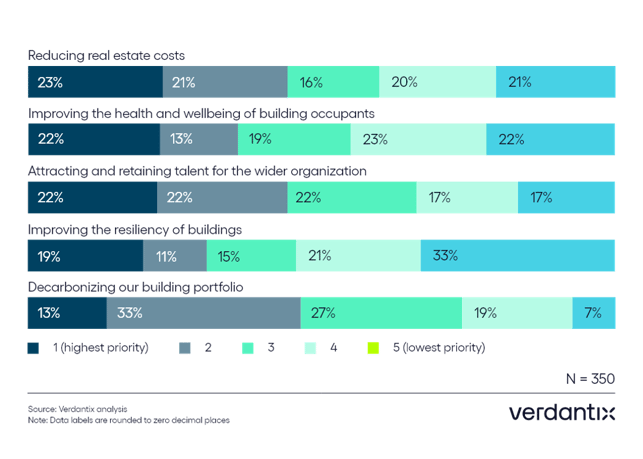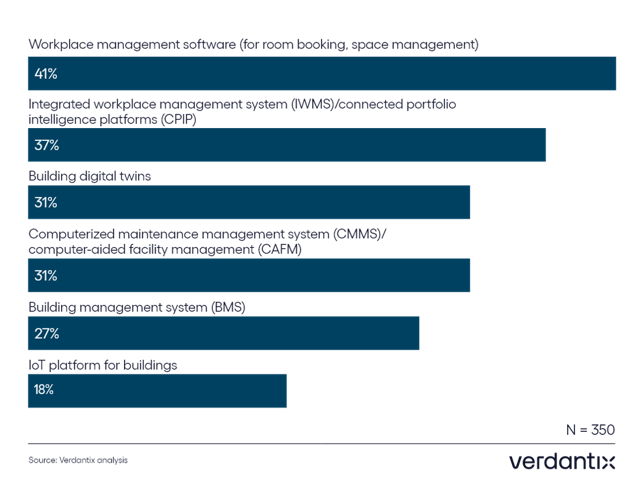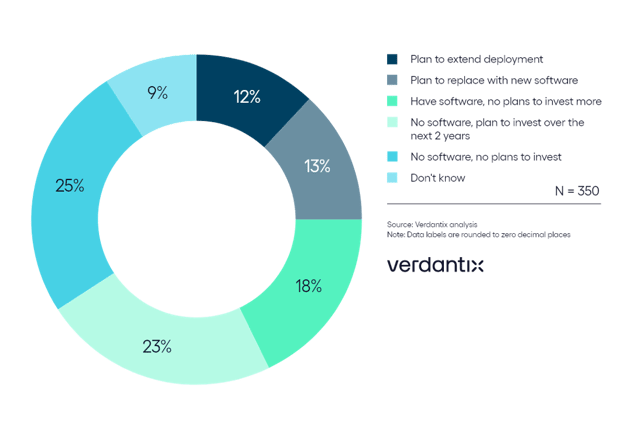Real estate management has come a long way since its humble beginnings. From manual record-keeping to the dawn of digitalization, this industry has constantly evolved to meet the changing needs of owners and occupants alike.
As we enter a new era, it's imperative for real estate professionals to set clear goals for the years ahead to stay ahead of the curve.
This is why we explore some key areas where real estate management can make significant strides: reducing costs, enhancing occupant wellbeing, attracting top talent, improving building resilience, decarbonizing portfolios – all while embracing innovation and digitalization.
TL;DR:
- In the past, real estate management relied on manual filing systems, while today technology is driving efficiency through innovative software solutions. Looking ahead, future trends such as AI and blockchain are expected to further optimize processes.
- Smart buildings that are based on occupancy and prevent problems through predictive analytics are also attracting growing interest – as is the focus on green practices, energy efficiency and reducing carbon footprints.
- Over the next three years, real estate managers have their sights set on goals such as cost reductions, occupant satisfaction, attracting top talent, building upgrades and going green. The benefits of going digital and using real estate software are also coming into focus.
- By leveraging innovation and digital tools, real estate managers can position themselves as leaders in an increasingly competitive market.
Real Estate Management: Past, Present, and Future
Real estate management has undergone a remarkable transformation over the years.
In the past, it was all about manual processes and paperwork. Real estate managers relied on cumbersome filing systems and spreadsheets to keep track of important information. However, with the advancements in technology, today's scenario is completely different.
Today, real estate professionals have access to sophisticated software solutions that streamline their workflows and provide valuable insights into property performance.
From digital leases and automated maintenance requests to data analytics tools for informed decision-making, technology has revolutionized the way real estate is managed.
The future holds even more exciting possibilities for real estate management. With trends like artificial intelligence (AI), the Internet of Things (IoT), and blockchain gaining momentum, real estate managers can expect further process optimization and greater efficiency.
Imagine a world where smart buildings automatically adjust temperature settings based on occupancy patterns, or where predictive analytics help identify potential issues before they become major problems.
These innovations not only save time, but also improve occupants’ satisfaction by creating smarter, more responsive environments.
In addition to technological advances, sustainability will also play a critical role in shaping the future of real estate management.
As society becomes more environmentally conscious, pressure is mounting on real estate managers to adopt green practices. These include energy-efficient building designs, integration of renewable energy sources and waste reduction strategies – all with the aim of reducing the carbon footprint while maximizing operational efficiency.
Real Estate Management Objectives for the Next Three Years
In the dynamic realm of real estate management, professionals have key goals for the future. Here are a few:
Reducing Real Estate Costs
Real estate costs can be a significant burden for businesses, impacting profits and hindering growth. One way to reduce them is to optimize the use of space. By adopting flexible work arrangements and embracing remote work options, companies can reduce their real estate needs.
Another approach to reducing costs is to take steps to increase energy efficiency. Investing in energy-efficient technologies can significantly reduce electricity bills over time. In addition, adopting sustainable building practices such as green roofs and rainwater collection systems can further reduce operating costs.
Technology can also help reduce unnecessary expenses. Implementing integrated real estate management software enables better monitoring of maintenance activities, leases and billing – ultimately saving time and money.
Improving Occupants’ Health & Wellbeing
By focusing on improving the health and wellbeing of occupants through various initiatives, real estate managers can create healthier environments that contribute to overall satisfaction.
For example, poor air quality can lead to various health issues such as allergies, respiratory problems and decreased productivity. By using modern ventilation systems and regularly monitoring air quality, real estate managers can ensure that occupants are breathing clean, fresh air.
Another aspect of improving occupant health is encouraging physical activity in buildings. Amenities such as gyms, walking trails or bike storage encourage residents to lead active lifestyles. Access to natural light and views of green spaces can also have a positive impact on mental wellbeing.
Attracting & Retaining Talent
In today's highly competitive job market, companies need to go above and beyond to attract talent. One strategy is to create enticing work environments that prioritize both employee wellbeing and productivity. Think abundant natural light, ergonomic furniture, green spaces, and cafeterias.
In addition, offering flexible work arrangements can be an important incentive for potential employees. As hybrid work arrangements become more popular, remote work opportunities or flexible work schedules can be very attractive to candidates seeking a better work-life balance.
Investing in professional development opportunities shows potential employees that your company values growth and advancement. Offering training programs or tuition reimbursement can help attract ambitious individuals who want to advance their careers.
Improving the Resilience of Buildings
With the increasing frequency and intensity of natural disasters and extreme weather events, it is critical that buildings are designed and constructed to withstand these challenges. Today's investments in resilient infrastructure will pay off in the long run by ensuring the safety of occupants.
One way to improve building resilience is through strategic planning and design. This includes using resilient materials during construction and ensuring proper maintenance and repair at a later date. Regular inspections can reveal potential weaknesses or vulnerabilities in the structure.
Integrating technology into building management systems can greatly improve resilience. Smart sensors and monitoring devices can detect issues such as leaks or electrical faults. By using data analytics and predictive maintenance tools, real estate managers can proactively address issues and prevent disruptions.
Decarbonizing Building Portfolio
Building construction and operation contribute significantly to greenhouse gas emissions. Fortunately, decarbonizing buildings is gradually becoming a priority for businesses around the world.
Verdantix, an independent market research firm, found that “whilst decarbonizing buildings is only a #1 priority for 13% of real estate execs, 33% view it as their #2 priority.”

Ranking of real estate objectives, next 3 years
Companies can take proactive steps to reduce their carbon footprint by implementing energy-efficient measures in buildings and investing in renewable energy sources such as wind power or geothermal energy. Integrating these clean energy solutions into the building portfolio helps reduce dependence on fossil fuels.
The use of green building materials in construction and renovation can also make an important contribution to decarbonization. These materials have a smaller carbon footprint than conventional materials and minimize emissions associated with production and transportation.
Innovation and Digitalization is Transforming Real Estate Management
Thanks to technological advances, real estate managers today have access to a wide range of tools and solutions that streamline their operations, increase efficiency and reduce environmental impact.
One major benefit of digitalization is the automation of routine tasks. Real estate management software enables seamless communication with tenants, automatic rent collection, maintenance tracking, and more.
This not only saves time, but also reduces human error and makes for a smoother process.
In addition, data analytics has proven to be a powerful tool for real estate managers, providing them with valuable insights into building performance, energy usage patterns, occupancy rates and other key metrics.
Last but not least, occupants are thrilled about smart buildings offering features such as smart locks, automated parking systems, mobile apps for booking amenities or reporting problems.
What Are the Benefits of Digitalization in Real Estate?
The digital revolution in the real estate industry brings a number of benefits for all stakeholders, such as:
- Less time spent on admin work. Through the use of digital tools and platforms, tasks such as lease administration, maintenance tracking, and financial reporting can be streamlined and automated.
- Better data analysis and decision-making. With access to real-time information on market trends, property performance and tenant preferences, real estate professionals can make more informed strategic decisions to optimize their portfolio.
- Improved communication and collaboration. Through online portals or apps, real estate managers can quickly and seamlessly communicate with both occupants and contractors or service providers to schedule repairs or preventive maintenance.
- Enhanced transparency for investors, thanks to comprehensive reports on property performance and financial metrics. This transparency builds trust between stakeholders and facilitates better risk assessment when making investment decisions.
- Digital solutions facilitate marketing and leasing processes by enabling virtual tours or 3D renderings of properties. Potential tenants have the opportunity to explore the premises remotely before deciding to view them.
By making the most of these technological tools, real estate professionals can compete in an increasingly competitive marketplace and deliver value to their clients.
Expected Investment Increase in Software Categories
The real estate industry is undergoing a profound transformation, and technology is playing a critical role in driving that change. Faced with the increasing complexity of managing multiple properties, real estate companies are turning to software solutions to streamline their operations.
From real estate management systems to predictive analytics tools, software offers immense potential for streamlining workflows and improving overall performance. For example, it can:
- Enables better data collection and analysis so that decisions can be made based on accurate insights.
- Proactively monitor building systems, resulting in cost savings through energy optimization.
- Advanced features such as AI can help automate routine tasks while reducing human error.
In their other analysis, Verdantix found that 41% of 350 real estate executives surveyed “plan to increase investment in workplace management software […] driven by hybrid working requirements and proven business value.”

Expected Investment Increase In Software Categories, Next 12 Months (2022)
The expected increase in investment in software categories offers real estate managers the opportunity to modernize their operations, remain competitive in today's market, and deliver an exceptional experience to tenants and investors alike.
Healthy Buildings: What Makes a Healthy Building?
We all know that a healthy workforce leads to higher productivity and overall satisfaction... but what exactly makes a building healthy?
- Air quality plays a critical role in creating a healthy environment. Proper ventilation systems that circulate clean air are essential to removing pollutants and allergens from indoor spaces. In addition, incorporating natural elements such as plants can help improve air quality by increasing oxygen levels.
- Another important aspect of a healthy building is lighting. Natural light has been shown to improve mood, boost energy levels and increase productivity. Therefore, when designing buildings, include as many windows and skylights as possible.
- Noise pollution is another factor to consider when designing a healthy building. Excessive noise can cause stress and poor concentration among occupants. Using sound-absorbing materials or applying acoustic design principles can help minimize noise pollution.
- In addition, temperature control is critical to occupant comfort and wellbeing. Maintaining optimal temperatures not only provides physical comfort, but also promotes better sleep patterns and overall cognitive performance.
- Encouraging physical activity indoors contributes to a healthier lifestyle for residents. Amenities such as outdoor workspaces and on-site gym and fitness facilities encourage regular physical activity during the workday.
By considering all these aspects when creating healthy buildings, companies can create environments that prioritize occupant health and contribute to long-term success.
The Role of Tech in a Healthy Building
When it comes to creating healthy buildings, technology plays a crucial role.
Verdantix also found that, “real estate and facilities managers are turning to technology to tackle the evolving healthy building agenda, with 48% of real estate decision-makers […] planning to increase efforts around supporting staff health and wellbeing in the workplace”

Software Plans To Support Staff Health And Wellbeing In The Office (2022)
With advances in smart building systems, real estate managers now have access to real-time data that can help optimize indoor environments. To keep things (very) short, here are a few examples:
- Sensors can monitor air quality parameters such as temperature, humidity, and CO2 concentration. Using this data, real estate managers can adjust ventilation rates or suggest air conditioning maintenance.
- Smart lighting systems can mimic natural light patterns throughout the day, which promotes circadian rhythms for occupants and improves overall wellbeing.
- Smart water meters can immediately detect leaks or abnormal consumption patterns, preventing water waste and potential damage.
- Security systems can provide a safe environment for building occupants. Real-time monitoring coupled with automated response mechanisms ensure quick action in the event of an emergency.
As we move into the future of real estate management, the integration of such technology solutions will be critical to creating healthier spaces that promote productivity and wellbeing.
Summing Up
The evolution of real estate management from its humble beginnings to today's digital landscape is just the beginning.
The future promises an even greater synergy between technology-driven innovation and sustainable practices that will redefine the way real estate is managed in the years to come.
To remain competitive and thrive in this changing landscape, real estate managers must harness the power of technology.
The key to achieving these goals efficiently and effectively lies in leveraging innovation and digitalization.
Software solutions tailored specifically to the needs of real estate management can unlock new growth opportunities while reducing costs and increasing occupants’ satisfaction.
The future of real estate management is promising for everyone – we're excited to see what it'll look like!











